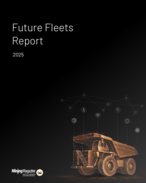Published in the May 2008 Coal USA Magazine
While underground coal technology has progressed over time, regulations on coal dust have not kept up – the most recent rules are more than 80 years old. The National Institute for Occupational Safety and Health and the Mine Safety and Health Administration conducted a joint survey recently on coal particle ranges as measured in US coal mine samples.
In underground coal mines, dust explosions are prevented by the addition of enough rock dust (usually limestone) to make the total dust mixture inert. The rock dust acts as a heat sink for the dispersed dust mixture by reducing the temperature below the value needed to propagate an explosion.
Federal regulations require 65% incombustible content in intake airways and 80% incombustible content in return airways, where the coal dust is assumed to be finer in size. The regulations also require an additional 1% incombustible for each 0.1% methane in the ventilating air in intakes and 0.4% additional incombustible for each 0.1% methane in returns.
The 65% incombustible content required for intake airways was based on the measured size of coal dust found in mines during the 1920s and the amount of rock dust required to inert that size of coal in full-scale experimental mine tests, as summarized by MSHA research.
The average size of the coal dust in mines measured in the 1920s survey was about 20% minus 200 mesh. Coal dust explosibility is strongly dependent on the fineness of the coal particles in a coal and rock dust mixture, with more rock dust required to inert finer size coal dust.
Underground coal mining technology has changed significantly since the 1920s as coal mining has become highly mechanized. Recently, NIOSH and MSHA conducted a joint survey to determine the range of coal particle sizes found in dust samples collected from intake airways of US coal mines.
This is the first comprehensive survey of this type since the 1920s. Dust samples were collected by MSHA inspectors from mines in each of MSHA’s 10 bituminous Coal Mine Safety and Health districts.
The NIOSH laboratory analysis procedures included acid leaching of the sample to remove the limestone rock dust, sonic sieving to determine the dust size, and low temperature ashing of the sieved fractions to correct for any remaining incombustible matter. The results indicate that particle sizes of mine coal dust in intake airways are significantly finer than those measured in the 1920s.
For example, the average sizes of the coal dust in MSHA Districts 2 (western Pennsylvania) and 11 (Alabama) are about 29% and 38% minus 200 mesh, respectively. The average sizes of the coal dust in MSHA Districts 6 and 7 (eastern and central Kentucky) are 32–35% minus 200 mesh.
As measured by coal seam, the average sizes of the coal dust from the Pittsburgh and Blue Creek seams are about 33% and 41% minus 200 mesh, respectively. This finer size coal dust measured in the recent intake airway survey would require more incombustible matter to be effectively inerted than the 65% incombustible specified in current regulations.
Currently, full-scale dust explosion tests are being conducted in the NIOSH Lake Lynn Experimental Mine to determine the amount of rock dust necessary to inert this finer size of coal dust that is found in modern coal mines.
NIOSH has developed a hand-held instrument, the Coal Dust Explosibility Meter (CDEM), which uses optical reflectance to measure the explosibility of a coal dust and rock dust mixture. The CDEM provides real-time results during rock dust surveys instead of waiting weeks for MSHA laboratory results. If the CDEM shows a hazard, the potential for a disaster can be mitigated immediately by adding more rock dust.
After proper calibration, the CDEM displays the percentage of incombustible content as well as a color indicating the relative explosibility of the coal and rock dust mixture. A red read-out indicates that more incombustible material is required to inert the coal and rock dust sample, while a green read-out indicates that the dust sample is sufficiently inert.
When the mixture is marginally explosible, a yellow read-out is indicated. The red-yellow-green explosibility reading takes into account the size of the coal dust as well as the amount of rock dust in the mixture.
For the field evaluation of the CDEM, NIOSH personnel accompanied MSHA inspectors on routine band surveys in five underground coal mines in southwestern Pennsylvania and three mines in Alabama. While underground, NIOSH personnel and MSHA inspectors used the CDEM to assess the explosibility of the dust samples.
The percentage of incombustible content determined by the CDEM agreed well with those values obtained later by low temperature ashing at MSHA and NIOSH laboratories. NIOSH is currently working with a manufacturer to commercialize this device in the near future.
Disclaimer: The findings and conclusions in this report are those of the authors and do not necessarily represent the views of the National Institute for Occupational Safety and Health or the Mine Safety and Health Administration.























